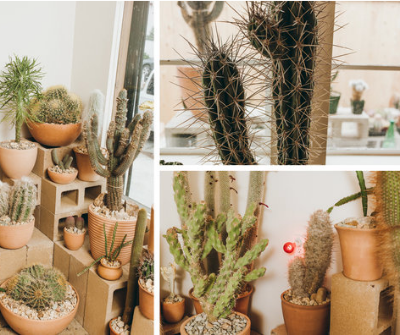For example, he says, “You can have a desert cactus indoors — you have to be very cautious about the amount of light and water. You always want to under-water indoors because you run into the issue of rot when there’s too much water in the soil for too long.” Below, he shares other tips for maintaining artful desert plants at home.
Create an urban oasis — with succulents
For city apartments, the Cactus Store recommends the euphorbia family (these are not technically cacti, but succulents), which can require a bit less light then other varietals and are better suited for indoors. Place plants as close as possible to the window and provide good air circulation, rotating them once a month to ensure even light.
Water sparingly
With indoor cacti, it’s better to under-water, about once a month, rather than over-water. A cactus can survive without water for many, many months; but rot is an instant killer. Using a moisture meter will eliminate all the guesswork; otherwise, you can water whenever the soil is completely dry.
Find a spot in the sun
If you can, leave your cacti outside during the growing months, from March to September, for a
happier, more robust look. (Be careful to introduce them to their new outdoor conditions gradually, otherwise they can get sunburned.) Return the rejuvenated plants indoors for the winter, when they can go dormant.
Drainage is key
Make sure to have a pot with drainage at the bottom, and include an inch of pumice or a small rock to aid in it.
Soil matters
Cacti do not like to sit in wet soil — or regular potting soil. Use only a specialized cactus mix, and after repotting in the new soil, do not water for two weeks. Planting typically breaks a cactus’s roots, and you don’t want to expose cut roots to water, as it can create rot.
Watch for warning signs
Early detection, and action, is a must:
- Thinning of the top growth means not enough light.
– Yellow scarring or splotches of extremities exposed to bright sun can mean sunburn.
– Thinning of overall cactus ribs means under-watering.
– White clumps or scale means insect infestation.
Source: www.nytimes.com





